In an age where regulatory demands can shift unexpectedly, small business owners need to understand that compliance is no longer a static obligation but an ongoing process. IBM’s recent launch of Guardium Data Protection 12.2 highlights this shift, delivering tools that promise to transform how businesses manage compliance and reduce associated risks.
The world of compliance is evolving; it’s not merely about passing annual audits anymore. Instead, it’s crucial for businesses to manage risks—financial, reputational, and operational—continuously. By adopting a mindset that treats compliance as an ongoing risk management discipline, organizations position themselves better to avert costly incidents and maintain customer trust.
Guardium’s latest features promote this continuous compliance approach, which is especially applicable to small businesses that may lack the resources of larger firms. The product’s key benefits revolve around transforming compliance from a once-a-year scramble into a constant state of readiness.
First, the compliance controls feature allows businesses to map their internal standards and external regulations onto Guardium’s monitoring framework seamlessly. This integration ensures that compliance activities like activity logging and access reviews are tied directly to daily operational processes rather than outdated documents. This document-free approach not only saves time but also minimizes human error, which is vital for smaller teams.
Next, Guardium introduces compliance thresholds, which provide real-time metrics on compliance status. This capability helps businesses track critical timelines, such as how quickly workflow tasks are completed or the percentage of compliance controls that are functioning properly. Early identification of deviations means small businesses can rectify issues before they escalate into greater problems, making this an invaluable tool for proactive management.
Moreover, the new compliance hub consolidates all relevant metrics into a single dashboard. Chief Information Security Officers (CISOs) and compliance leaders can easily spot effective controls, growing risks, and areas requiring immediate attention. For small business owners, this means enhanced visibility into their compliance posture and decision-making based on actionable insights.
The continuous compliance model reduces the manual effort typically associated with maintaining compliance, simultaneously strengthening oversight and ensuring ongoing audit readiness. As one IBM spokesperson noted, “Compliance becomes both a business enabler and a proactive risk reduction strategy—measured, visible, and integrated.”
Yet, while the benefits are clear, these advancements come with potential challenges. Small business owners need to consider the initial learning curve associated with adopting a new compliance management system. Transitioning to Guardium 12.2 will require staff training and adjustments to existing processes, which could temporarily divert focus from other operational priorities.
Additionally, as small businesses frequently operate with fewer resources, integrating such a comprehensive compliance solution might initially seem daunting. They may need to assess whether their current infrastructure can support ongoing compliance oversight or if additional investment in technology will be necessary. The opportunity to consolidate and streamline compliance processes may be beneficial in the long run, but careful planning is essential to ensure a smooth transition.
As businesses become increasingly reliant on hybrid data environments, being equipped with the right tools for continuous compliance is crucial. The commitment to compliance today can significantly influence a business’s ability to thrive tomorrow. Companies that leverage advancements like IBM’s Guardium Data Protection 12.2 stand to benefit not just in regulatory terms but in overall operational efficiency and stakeholder trust.
For small businesses keen on navigating the evolving compliance landscape, exploring solutions such as Guardium may not just be a strategic advantage but a necessary adaptation to industry changes. To learn more about these advancements from IBM, you can visit their announcement here.
Image Via BizSugar



